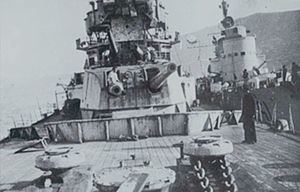Date 26 March 1941 | Result Italian victory | |
 | ||
Similar World War II, Battle of the Strait of Otranto, Operation Abstention, Battle of the Ligurian, Battle of the Tarigo Convoy | ||
The Raid on Souda Bay was an Italian Royal Navy small craft assault on Souda Bay, Crete, during the first hours of 26 March 1941. The Royal Navy heavy cruiser HMS York, and the Norwegian tanker Pericles were disabled by Italian motor launches and eventually lost.
Contents
Background
Souda is a naturally protected harbor on the northwest coast of the island. It had been chosen as a target by the Decima Flottiglia MAS months before because of the almost continuous Allied naval activity there. Air reconnaissance had spotted a number of naval and auxiliary steamers at anchor in Souda Bay, Crete.
On 25 March 1941, the Italian destroyers Crispi and Sella departed from Leros island in the Aegean at night, each one carrying three 2 long tons (2.0 t) motor assault boats of the Decima known as Motoscafo da Turismo (MT). Each MT (nicknamed barchino - "little boat") carried a 300 kg (660 lb) explosive charge inside its bow. The MTs were specially equipped to make their way through obstacles such as torpedo nets. The pilot would steer the assault craft on a collision course at his target ship, and then would jump from his boat before impact and warhead detonation.
The attack
At 23:30, the MT were released by the destroyers 10 mi (8.7 nmi; 16 km) off Souda. Once inside the bay, the six boats, under the command of Lieutenant Luigi Faggioni, identified their targets: the heavy cruiser HMS York, a large tanker (the Norwegian Pericles of 8,300 long tons (8,400 t)), another tanker and a cargo ship. At 4:46, two MTs hit HMS York amidships, flooding her aft boilers and magazines, and the ship was beached by her own crew to avoid capsizing. Two seamen were killed by the explosions. Pericles was severely damaged and settled on the bottom, while the other tanker and the cargo ship were sunk, according to Italian sources. According to British reports, the other barchini apparently missed their intended targets, and one of them ended stranded on the beach. The anti-aircraft guns of the base opened fire randomly, believing that the base was under air attack.
All six of the Italian seamen: Luigi Faggioni, Alessio de Vito, Emilio Barberi, Angelo Cabrini, Tullio Tedeschi and Lino Beccati, were captured.
Aftermath
HMS York was disabled. After a salvage operation involving a submarine dispatched from Alexandria was abandoned, she was wrecked with demolition charges by her crew before the German capture of Crete, while Pericles, taken in tow by destroyers, sank on 14 April 1941 en route to Alexandria during a gale.
The sinking of HMS York was the source of a controversy between the Regia Marina and the Luftwaffe over credit for her sinking. The matter was resolved by British war records and by the ship's own war log, captured by Italian naval officers who boarded the half-sunk cruiser.
After the war, the hull of HMS York was towed to Bari and scrapped there by an Italian shipbreaker in March 1952.
